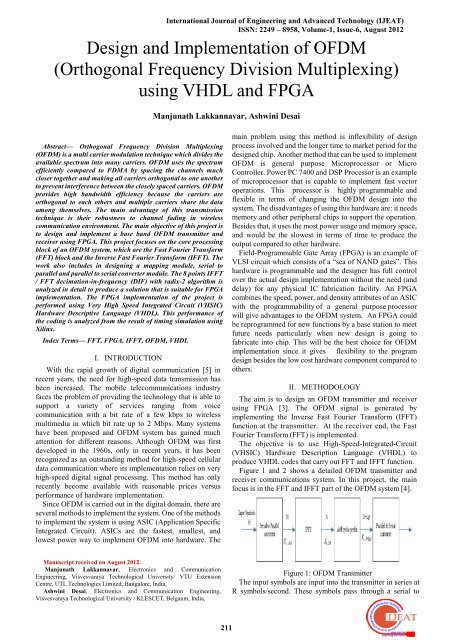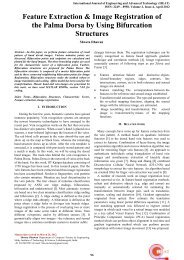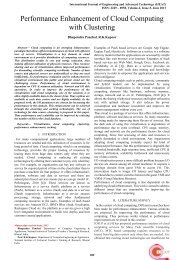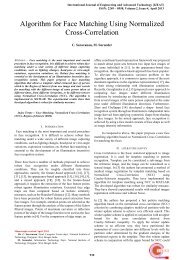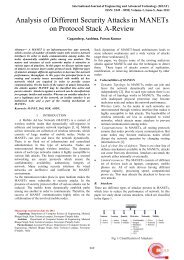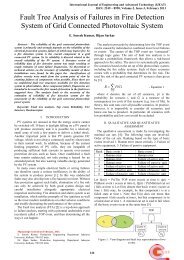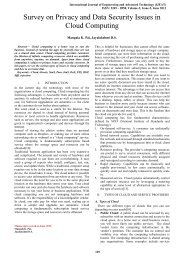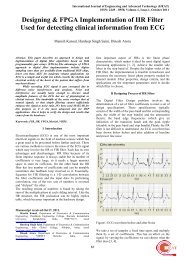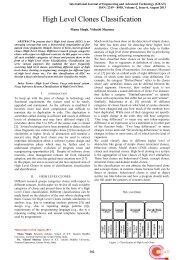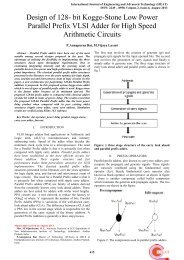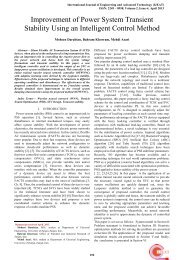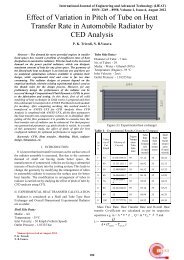Orthogonal Frequency Division Multiplexing - International Journal ...
Orthogonal Frequency Division Multiplexing - International Journal ...
Orthogonal Frequency Division Multiplexing - International Journal ...
- No tags were found...
Create successful ePaper yourself
Turn your PDF publications into a flip-book with our unique Google optimized e-Paper software.
Design and Implementation of OFDM (<strong>Orthogonal</strong> <strong>Frequency</strong> <strong>Division</strong> <strong>Multiplexing</strong>) using VHDL and FPGAparallel converter and output data on M lines in parallel. Thedata rate on every M line is R/M symbols/second. A symbol inthis parallel stream of data is denoted as Xi, k. The index i referto which sub channel the symbol belongs to, and i ranges from1 to M. The k denotes the k-th collection of M symbols. Thesub symbol collection from X1,k to XM, k makes up anOFDM symbol.The M symbols are sent to an Inverse Fast FourierTransform (IFFT) block that performs N-point IFFToperation. The IFFT transform a spectrum (amplitude andphase of each component) into a time domain signal. An IFFTconverts a number of complex data points, of length that ispower of 2, into the same number of points in time domain.Each data point in frequency spectrum used for an FFT orIFFT operation is called a bin. The output is N time-domainsamples.In order to preserve the sub-carrier orthogonality and theindependence of subsequent OFDM symbols, a cyclic guardinterval is introduced. Time and frequency synchronizationcan be established by means of cyclic extension in the prefixand the postfix period.In this case, assumed a cyclic prefix of length Lp samples ispre-pended to the N samples to form a cyclically extendedOFDM symbol. The cyclic prefix is simply the last Lp samplesof the N inverse Fast Fourier Transform output samples.For example, assumed N=4 and Lp=2. If the outputs of a 4point inverse Fourier transform is [1 2 3 4]. The cyclic prefixwill be [3 4]. The cyclically extended symbol would be [3 4 1 23 4]. Therefore, the length of the transmitted OFDM symbol isN+ Lp.Pre-pending the cyclic prefix aids in removing the effects ofthe channel at the receiver. ISI can occur when multi pathchannel cause delayed version of previous OFDM symbol tocorrupt the current received symbol. If the value of Lp isgreater than or equal to the size of the transmission channel,the ISI will only affect the cyclic prefix.The actual OFDM symbol will arrive unchanged. The cyclicprefix makes the OFDM symbol appear periodic over the bandof interest. The cyclically extended symbols are passedthrough a parallel-to-serial converter. They are transmitted inseries across the channel response of the OFDM symbol withthe frequency response of the channel.Figure 2: OFDM ReceiverThe received symbol is in time domain and it isdistorted due to the effect of the channel. The receivedsignal goes through a serial to parallel converter andcyclic prefix removal.After the cyclic prefix removal, the signals are passedthrough an N-point fast Fourier transform to convert thesignal to frequency domain. The output of the FFT isformed from the first M samples of the output.III. RESULTSA. Simulation Result of Transmitter.Figure 3: Simulation result of Transmitter.B. Simulation Result of ReceiverFigure 4: Simulation result of Receiver.VI. CONCLUSIONThe objective is the implementing the core processingblocks of an <strong>Orthogonal</strong> <strong>Frequency</strong> <strong>Division</strong> <strong>Multiplexing</strong>(OFDM) system, namely the Fast Fourier Transform (FFT)and Inverse Fast Fourier Transform (IFFT).The Fast Fourier Transform (FFT) and Inverse Fast FourierTransform (FFT) have been chosen to implement the designinstead of the Discrete Fourier Transform and InverseDiscrete Fourier Transform because they offer better speedwith less computational time. These methods requires the oddand even samples inputs are process separately before they arecombine to give the final output. The result of thecomputation is in integer bits which might comprises of realand imaginary components. The decimal value of the outputif greater than 0.5 is approximated to 1 and vice versa.The design implementation is done using VHDL coding.Direct mathematical method is adopted because it is anefficient and optimized method instead of the structuralimplementation which is based on butterfly operation.VII. ACKNOWLEDGMENTThe authors would like thank the support of Department ofElectronics and Communication Engineering, KLECET,Belgaum, Karnataka and UTL Technologies Limited,Bangalore, Karnataka.212
REFERENCES[1]. “<strong>Orthogonal</strong> <strong>Frequency</strong> <strong>Division</strong> <strong>Multiplexing</strong> (OFDM) Explained”,Magis Networks, Inc., February 8, 2001, www.magisnetworks.com.[2]. “An Introduction to OFDM”, <strong>International</strong> Engineering Consortium(IEC), http://www.iec.org/online/tutorial/ofdm/topic04.html.[3]. Design of an OFDM Transmitter and Receiver using FPGA, Loo KahCheng, UTM, 2004.[4]. Implementation of 8 point IFFT and FFT for OFDM System, NorHafizah Bt Abdul Satar, UTM, 2004.[5]. “Advantages of OFDM”http//pic.qcslink.com/introPLC/AdvOFDM.htm.[6]. Communication Systems, Simon Haykin, 4th Edition, Wiley 2000.Manjunath Lakkannavar was born in Dharwad, Karnataka in 1986. Hereceived the B.E. degree in Electronics and Communication Engineeringfrom SDMCET, Dharwad, Karnataka in 2008, and M.Tech degree in VLSIDesign and Embedded Systems from KLECET, Belgaum, Karnataka in2010. In 2010, he joined UTL Technologies Limited as AssociateConsultant-VLSI department. His research interests are, Image Processing,Digital Communications, etc. He became a Guest of Honor and SessionChair for <strong>International</strong> Conference, 2012.Ashwini Desai born in Karnataka. She received B.E. in Electronics andCommunication Engineering and M.Tech in VLSI Design and EmbeddedSystems. Her research work is Algorithm for Physical Design of VLSISystems. She is working as a Professor in Electronics and CommunicationEngineering Department in KLECET, Belgaum with an experience of 17years. She is perusing PhD.<strong>International</strong> <strong>Journal</strong> of Engineering and Advanced Technology (IJEAT)ISSN: 2249 – 8958, Volume-1, Issue-6, August 2012213


